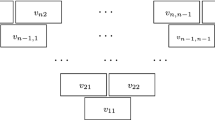Abstract
In this note we reverse theusual process of constructing the Lie algebras of types G 2and F 4 as algebras of derivations of the splitoctonions or the exceptional Jordan algebra and instead beginwith their Dynkin diagrams and then construct the algebras togetherwith an action of the Lie algebras and associated Chevalley groups.This is shown to be a variation on a general construction ofall standard modules for simple Lie algebras and it is well suitedfor use in computational algebra systems. All the structure constantswhich occur are integral and hence the construction specialisesto all fields, without restriction on the characteristic, avoidingthe usual problems with characteristics 2 and 3.
Similar content being viewed by others
References
W. Bosma, J. Cannon, and C. Playoust, The Magma algebra system I: The user language, J. Symbolic Comput., Vol. 24 (1997) pp. 235–265.
R. W. Carter, Simple Groups of Lie Type, Pure and Applied Mathematics. John Wiley & Sons, London New York Sydney Toronto, Vol. XXVII (1972).
C. Chevalley and R. D. Schafer, The exceptional simple Lie Algebras F 4 and E 6, Proc. Nat. Acad. Sci. U.S.A., Vol. 36 (1950) pp. 137–141.
H. S. M. Coxeter, Integral Cayley numbers, Duke Math. J., Vol. 13 (1946) pp. 561–578.
J. R. Faulkner and J. C. Ferrar, Exceptional Lie algebras and related algebraic and geometric structures, Bull. London Math. Soc., Vol. 9 (1977) pp. 1–35.
H. Freudenthal, Oktaven, Ausnahmegruppen und Oktavengeometrie, Geom. Dedicata, Vol. 19 (1985) pp. 1–63.
R. B. Howlett, L. J. Rylands, and D. E. Taylor, Matrix generators for exceptional groups of Lie type, submitted J. Symbolic Comput., Vol. 00 (2000), 000–000.
J. E. Humphreys, Introduction to Lie Algebras and Representation Theory, Graduate Texts in Mathematics, Springer-Verlang, New York Heidelberg Berlin, 9 (1972).
N. Jacobson, Cayley numbers and simple Lie algebras of type G 2, Duke Math. J., vol. 5 (1939) pp. 775–783.
M.-A. Knus, A. Merkurjev, M. Rost, and J. P. Tignol, The Book of Involutions, Colloquium Publications, Vol. 44, Amer. Math. Soc., Providence, RI (1998).
M. A. A. van Leeuwen, A. M. Cohen, and B. Lisser, Lie Manual, Version 2.1, Computer Algebra Group, CWI, Amsterdam (1993).
R. D. Schafter, An Introduction to Nonassociative Algebras, Pure and Appled Mathematics, Academic Press, New York London, 22 (1966).
M. Schönert et al., GAP-Groups, Algorithms and Programming, Lehrstuhl D für Mathematik, RWTH Aachen (1994).
J. R. Stembridge, A Maple Package for Root Systems and Finite Coxeter Groups (Version 2.1), Maple Share Library (1998).
Author information
Authors and Affiliations
Rights and permissions
About this article
Cite this article
Rylands, L.J., Taylor, D.E. Constructions for Octonion and Exceptional Jordan Algebras. Designs, Codes and Cryptography 21, 191–203 (2000). https://doi.org/10.1023/A:1008399914122
Issue Date:
DOI: https://doi.org/10.1023/A:1008399914122



